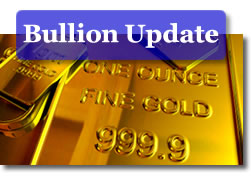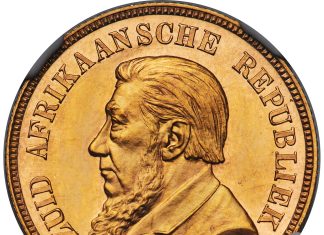 New York gold futures fell for a second straight day and to a three-week low as the US dollar rose against other currencies.
New York gold futures fell for a second straight day and to a three-week low as the US dollar rose against other currencies.
The yellow metal retreated to below $1,100 an ounce before settling just above the mark, but still registered a 0.8 percent loss on the day. Silver and platinum declined 2.1 percent and 1.6 percent, respectively.
A theme cited for metal declines as well as tumbling US stocks was President Obama’s proposal to increase bank regulations in order to limit their risk-taking.
New York crude oil fell for a second day as the Energy Information Administration reported lower demand for fuel. Concerns over tightened China lending was also given as a reason for oil’s 2.1 percent drop.
New York precious metal figures follow:
-
Gold for February delivery declined $9.40 to close at $1,103.20 an ounce. It ranged from $1,117.40 to $1,088.00.
-
Silver for March delivery fell 37 cents to finish at $17.510 an ounce. It ranged from $18.065 to $17.340.
- April platinum lost $25.50 to end at $1,592.10 an ounce. It ranged from $1,634.50 to $1,590.00.
In PM London bullion, the benchmark gold price was fixed earlier in the North American day to $1,108.25 an ounce, which was down $12.00 from Wednesday. Silver plunged 80 cents to $17.680 an ounce. Platinum was settled at $1,612.00 an ounce for a loss of $15.00.
Notable bullion quotes follow:
"Gold has been very responsive to the dollar of late," Leonard Kaplan, the president of Prospector Asset Management in Evanston, Illinois, said on MarketWatch. "As the dollar rallies, gold is going to go a lot lower."
"The next session or two will be very important," Matt Zeman, a metals trader at LaSalle Futures Group in Chicago, said on Bloomberg. "We need to see gold snap back fairly quickly. If gold can’t recapture the 50-day, you’ve got to get bearish very quickly."
"US currency continued its ascent on the trade-weighted index, receiving a further boost from safe-haven seekers spooked by the prospect of easy money supplies drying up all over the place," wrote Jon Nadler, senior analyst at Kitco Metals, Inc.
"As a result of the Chinese news and the ensuing surge in the US dollar, gold prices fell to just under $1100 during the overnight hours. The breach of that level could portend a test-target near $1075-$1080 should a close beneath $1112 materialize over the next couple of sessions." [Read Nadler’s full commentary.]
Gold, considered a hedge during times of high inflation and economic uncertainty, tends to follow oil and move opposite to the U.S. dollar. A rising greenback makes dollar-denominated commodities, like bullion, more expensive for holders of other world currencies.
In related bullion news covering the United States Mint, 2010 Silver Eagles sales exploded. Newly dated bullion eagle coins were released on Tuesday. In less than two days, US Mint records show an astounding 2,480,000 were purchased. Put another way, in less than 48 hours the Mint sold over 8.6% of the total number of Silver Eagles it had sold in all of 2008.
The one ounce Gold Eagle bullion coins also performed well, especially after considering that the Mint is requiring authorized purchasers to buy one 2009-dated coin for every three 2010 coins (until the 2009s are depleted). 69,000 have been sold so far this month.
Oil and gasoline prices
Oil futures fell, "as a report of a drop in U.S. crude supplies wasn’t enough to offset concerns about low demand and about China’s efforts to cool its growth," wrote Polya Lesova of MarketWatch.
"Refineries aren’t running and we still got a big build in gasoline inventories," Phil Flynn, vice president of research at PFGBest in Chicago, said on Bloomberg. "This is a signal that demand is very weak in the U.S., and there is no sign that it will increase anytime soon."
New York crude-oil for March delivery plummeted $1.66, or 2.1 percent, to $76.08 a barrel.
The national average for regular unleaded gasoline fell four-tenths of a cent to $2.733 a gallon, according to AAA fuel data. The current average is 2.5 cents lower than last week, 14.8 cents more than a month back, and 88.5 cents above the price of a year ago.
U.S. Stocks
U.S. stocks fell and a "selloff accelerated Thursday afternoon after the Obama administration announced a proposal to increase regulation of the nation’s biggest financial firms, including limiting the size and scope of their trading operations," wrote Alexandra Twin of CNNMoney.
"The rhetoric out of Washington is horrifying to people and it seems like every day another noose is being tied around the necks of the banks," Peter Boockvar, equity strategist at Miller Tabak & Co. in New York, said on Bloomberg. "And Wall Street has finally woken up to the cooling action in China after having ignored it for the past month."
The Dow Jones industrial average fell 213.27 points, or 2.01 percent, to 10,389.88. The S&P 500 index lost 21.56 points, or 1.89 percent, to 1,116.48. The Nasdaq Composite index slid 25.55 points, or 1.12 percent, to 2,265.70.
Gold, Silver, and Metals: Prices and Commentary – Jan. 21
by Jon Nadler, Kitco Metals Inc.
Good Morning,
Metals markets made it eminently clear yesterday that they loathe anything to do with the idea of tightening and the curbing of bubbles. As a result of the Chinese news reports that some local banks have already been told by the Chinese government to stop lending or suffer penalties, most commodities declined sharply on Wednesday. The dollar continued to trounce the euro as the "Greek tragedy" plays out over in the Old World and analysts at UniCredit SpA envision a possible 1.39 common currency value against the greenback.
Today’s picture hardly looks any different, as news that China’s economy grew at the fastest pace since 2007 (GDP up 10.7% year on year!) only stoked additional fears that local authorities will grab the tightening noose in earnest and start pulling on it any day now. China is this close to taking the number two spot on the global economic hit parade, but bubbles are something its leaders have made explicitly clear they do not want, albeit in the opinion of many an analyst, they already have them.
The slump continued overnight, after several attempts at stabilization failed to elicit much interest in fresh buying. Market analysts are pointing to record lows in forward gold lease rates – a signal that either there is no metal available for swaps or leasing (hardly the case) or that savvy players are engaged in heavy forward selling (more than likely, given long and short position profiles on COMEX).
Meanwhile, the US currency continued its ascent on the trade-weighted index, receiving a further boost from safe-haven seekers spooked by the prospect of easy money supplies drying up all over the place. This morning’s latest check showed the greenback at 78.62 on the index. Over in the oil pits, crude was hovering just under $78 per barrel, awaiting fresh inventory figures from the US. Commerzbank analysts envision a drop in black gold that could bring it to just under $71 per barrel, following its failed attempt at overcoming resistance at $84 last week.
As a result of the Chinese news and the ensuing surge in the US dollar, gold prices fell to just under $1100 during the overnight hours. The breach of that level could portend a test-target near $1075-$1080 should a close beneath $1112 materialize over the next couple of sessions.
Analysts over at Goldessential.com remarked that: "it’s a combination of factors that have deteriorated sentiment and have increased the belief that gold is overpriced; the Euro residing at five month lows, inflation data that keeps tame and investment demand that is, well, mostly inexistent".
He added that: "An over 13,000 lots-large February gold put option at $1,100 is expiring next week, and has gained attention as prices work their way in this direction". "A break below here could give bears fresh breath, while a key technical trend support is near $1,102.50, and a break here would seriously deteriorate charts and open for a re-test of the December $1,075.20 an ounce lows."
Such conditions made for a once again lower opening in New York this morning. Gold started off with an $8.30 per ounce loss, quoted at $1103.00 amid fairly hefty liquidation patterns. The question of the day may yet become not whether the metal can close above $1112 but whether it could possibly finish under the $1100 mark – an area not seen since…well, last year’s end. Today’s initial jobless claims numbers could dent the dollar and temporarily halt its recent advance, while providing some modicum of help to gold it its attempts to hold the $1100 mark. Thus, we will go with the ‘it’s too early to tell’ scenario for now.
Silver fell 24 additional cents on the open, starting at $17.63 an ounce, while platinum gave back $22 more this morning, to reach $1601 per troy ounce. Palladium lost $7 to ease back to $459 per ounce. The noble metals ETFs may have siphoned funds away from the star of the show –the SPDR Gold Trust over recent weeks.
Up-to-date analysis provided by Reuters reveals that the famed GLD has suffered from a near 2% loss in balances thus far this year, with nearly 22 tonnes of yellow metal leaving for greener (whiter?) pastures. Ditto for the iShares Silver Trust, which lost 154 tonnes of silver during this very early part of 2010. The gainers in holdings? Why, yes, the newborn platinum and palladium vehicles. Taking risk where rewards are still seen as possible. Reducing risk where prospects appear less than stellar. And the speculative plays roll on…
Speaking of risk, and curbs, and such – the new fashionable trend that 2010 appears to be bringing – here is something to ponder in the latest offering from Marketwatch:
"U.S. President Barack Obama is expected to propose Thursday new limits on the size of banks and the risks they may take, The Wall Street Journal reported late Wednesday. The proposal aims to deter banks from becoming so large that they put the broader economy at risk, and also to prevent them from growing large enough to distort normal competitive forces, the report said, citing congressional sources and administration officials.
The president is also expected to endorse some recommendations by former Federal Reserve chairman Paul Volcker, placing restrictions on commercial banks so as to prevent them from using federally insured deposits to finance speculative activity, the report said." – We keep mentioning Mr. Volcker as one ‘advisor’ to the administration who is highly worth watching – on all issues of potential interest.
The markets will continue to be volatile as we close out the week, but the technical damage cannot/should not be ignored. Policies (see China, see the US banking issues above) as well as perceptions among investors (see…the markets) are perceptibly shifting as we roll into what could be a year of change from ingrained trends in the markets.
Until tomorrow,
Jon Nadler
Senior Analyst
Kitco Metals Inc.
North America
Blog: http://www.kitco.com/ind/index.html#nadler
Check out other site market resources at Bullion Prices, Silver Coins Values and the US Inflation Calculator which easily finds how the buying power of the dollar has changed from 1913-2009.










